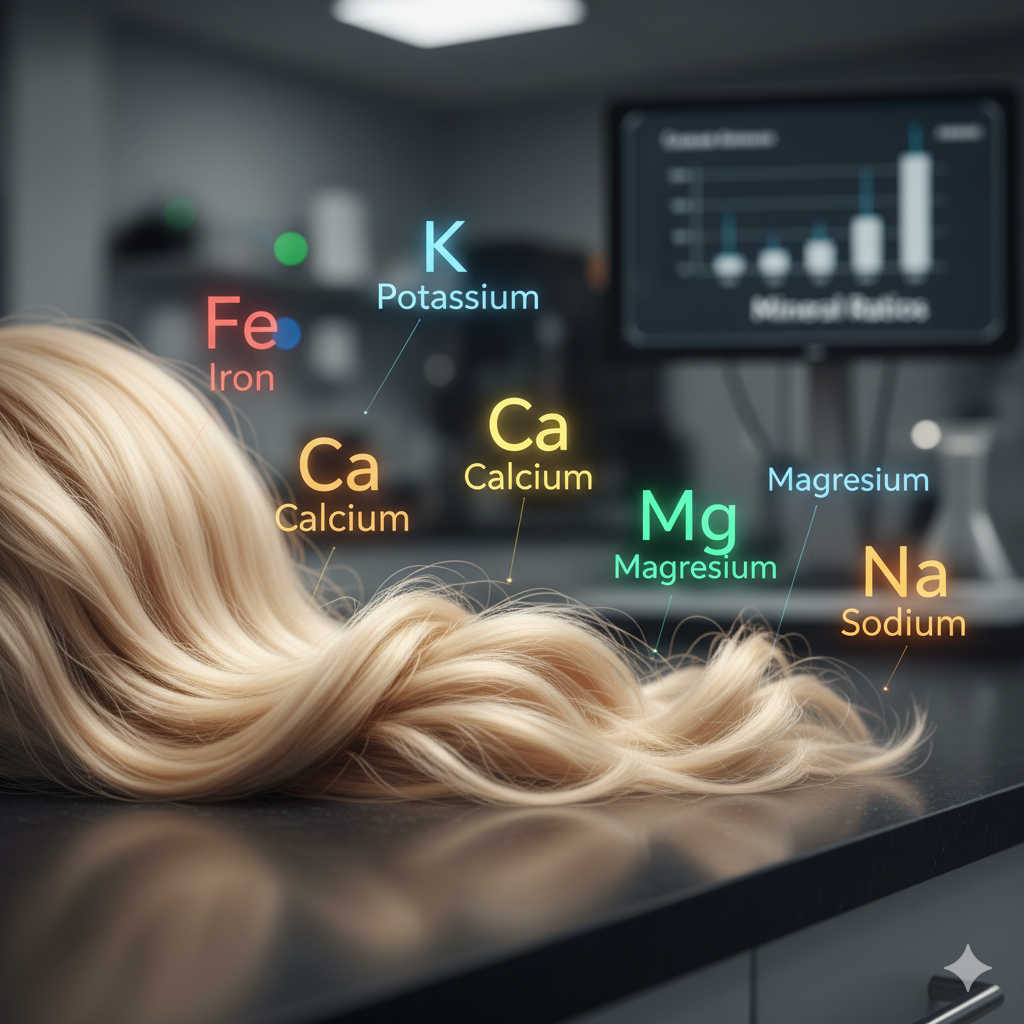HTMA, the Unknown Science; Why is it so Important?
Hair Tissue Mineral Analysis (often abbreviated HTMA) is a practical, affordable starting point when you want real answers about your mineral status instead of guessing which supplements to buy. Many people spend anywhere from $5 to over $500 on vitamins and products that may help a little — or not at all — because they don’t know what their body actually needs. Rather than throwing money at random bottles, starting with a targeted test gives you clear, actionable information about your body's mineral activity.
As a former head nutritionist in large natural food stores, I saw how confusing the supplement aisle can be. What changed my practice — and my health — was using laboratory data first. A
reliable hair mineral analysis provides a baseline of tissue mineral ratios so you (and your clinician) can make intelligent choices about diet and supplementation instead of guessing.
The goal is balance — particularly a proper balance of essential minerals in the tissues. When mineral ratios are in range, many body systems (energy, hormones, muscles, and bones) function more efficiently. In clinical observation, a large proportion of clients show elevated tissue calcium and related mineral imbalances that slow metabolism and interfere with absorption of nutrients like magnesium, potassium, phosphorus, and iron. Rather than presenting that figure as an absolute population statistic, I present it as an observed pattern in practice that underscores the importance of testing before supplementing.
This article will explain how a hair tissue mineral analysis works, what the lab report looks like, how to collect a proper hair sample, and why understanding mineral status can change your approach to health. Read on for practical steps and a short FAQ at the end to help you decide whether HTMA or another form of mineral testing is right for you.
The Science Behind HTMA Laboratory Testing
The accuracy of a hair tissue mineral analysis depends on both the targets you measure and the laboratory methods used. Reputable labs use highly sensitive instrumentation and strict quality-control procedures so the tiny amounts of minerals and metals in hair can be measured reliably.
Most modern testing labs use Inductively Coupled Plasma Mass Spectrometry (ICP‑MS) to quantify trace elements in hair. ICP‑MS offers excellent sensitivity for both essential minerals and low-level heavy metals, which makes it a preferred method for reliable hair mineral testing.
Before analysis, hair is cleaned and digested so the lab can measure internal content rather than surface contaminants. Many labs use an acid digestion protocol (often performed with microwave-assisted systems) to break hair into a solution that ICP‑MS can analyze for trace amounts of sodium, potassium, calcium, magnesium, iron and other elements, as well as low-level toxic metals.
Quality control matters: good labs use certified reference materials, blanks, spike recoveries and routine calibration checks to make sure measurements are stable and accurate over time. Protocols vary by provider, so look for labs that publish their QA/QC approach or that use internationally recognized standards.
If you want to learn more about specific laboratory methods, reliable overviews of ICP‑MS and hair analysis are available from analytical chemistry sources and public health laboratories — include one or two links to lab method references in the final article for readers who want the technical background.
In short: choose a lab that uses ICP‑MS or similar high-sensitivity instrumentation, follows transparent QA/QC protocols, and provides clear patient and practitioner reports. That combination gives you the most useful and trustworthy information from your hair test results.
How Are HTMA Reports Structured?
Here’s what you typically receive when you order a hair tissue mineral analysis (also called a hair mineral analysis or mineral analysis hair by some labs): a clear, patient-friendly summary and a more technical practitioner report. Together they give both the big-picture guidance and the fine details a clinician needs to act.
Reports are designed to be useful at two levels:
- For patients: A plain-language overview that explains key results, notable mineral patterns, and practical next steps (diet, lifestyle, or referral). Think of it as a personalized mineral road map you can follow without a chemistry degree.
- For practitioners: A technical report with tables, charts and clinically useful ratios (for example Ca/Mg and Na/K), trace element concentrations, and notes about potential toxic metals or patterns that suggest metabolic tendencies. This level helps a clinician fine-tune a treatment or testing plan.
Common report features to look for:
- Absolute concentrations of elements (e.g., Ca, Mg, Fe, Zn) expressed in ppm or mg/kg.
- Element ratios (e.g., Ca/Mg, Na/K) that offer insight into metabolic tendencies and tissue balance.
- Toxic metal markers (lead, mercury, cadmium, etc.) when measured and flagged by the lab.
- Interpretive comments that translate results into potential dietary, lifestyle, or testing recommendations.
Many labs include small visuals—a color-coded chart or bar graph—that make it easier for patients to see which elements are low, adequate, or high. In the full rewrite, add a thumbnail example of a patient page and a sample chart annotation to help readers understand how to read their own hair analysis report.
If you’re ready to see how a report looks, check the next section on sample collection, then follow the CTA to view an example HTMA report or order a kit from a lab that provides both patient and practitioner-level reports.
How Is a Hair Sample Collected for Mineral Analysis?
Collecting a clean, well-documented hair sample is one of the most important steps to getting useful hair testing or hair mineral testing results. It’s quick, non-invasive, and you can usually do it at home with a kit. Below is a simple, numbered checklist you can follow.
- 1) Choose the right spot: Collect hair from the back of the head, near the nape (closest to the scalp). This area is least likely to be contaminated by styling products and tends to have consistent growth.
- 2) How much hair: Most labs ask for a pencil-width bundle (roughly 50–125 mg, commonly described as about a tablespoon). Check your kit’s instructions—exact amounts vary by lab.
- 3) Cutting technique: Cut as close to the scalp as possible—the proximal end of the hair reflects more recent tissue status. Place the cut bundle so the scalp end is marked or obvious.
- 4) Avoid contamination: Wash hair 24–48 hours before sampling and avoid conditioners, oils, or leave-in products. Do not use hair treatments (coloring/bleaching) immediately before sampling if possible — if hair is chemically treated, note this on the submission form.
- 5) Package and label: Place the bundle in a clean envelope or provided collection packet. Clearly label with your name, date, and the collection site (e.g., “nape, left side”). Follow the kit’s mailing instructions to send to the laboratory.
Quick notes and alternatives: If you are bald, severely short-haired, or wearing extensions, ask the lab about acceptable alternatives — some labs accept body hair (scalp is preferred) or recommend an in-person collection. If your hair is chemically treated, indicate that on the form because treatments can affect surface contamination and interpretation.
Typical lab turnaround is 1–3 weeks depending on the provider and shipping — check the lab’s stated testing time when you order a kit. Once results arrive, review the patient summary first and then the practitioner report if you have a clinician to help interpret technical ratios.
Want a printable checklist or a label template? Add a CTA here in the final article like “Download collection instructions” or “Order a home kit” linking to your preferred lab or resources for a step-by-step collection guide.
In clinical observation, many clients present with elevated tissue calcium and corresponding mineral imbalances that reduce the tissue availability of nutrients such as phosphorus, potassium, iron and magnesium. These antagonistic patterns—where one element’s excess is associated with lower tissue levels of others—can affect muscle strength (including the heart), bone density, and general metabolic function. Rather than presenting population percentages as absolute facts, I report prevalence as an observed trend in practice and encourage confirmation with systematic studies or lab data.
How Mineral Imbalances Impact the Body
Mineral imbalances and exposure to toxic heavy metals are associated with a broad range of health concerns—from cardiovascular disease and metabolic disturbances to fatigue, cognitive issues, and developmental problems in children. Importantly, tissue tests like HTMA can reveal shifts in element levels and ratios before symptoms or conventional blood tests detect major problems, making them useful for early detection and prevention when interpreted by a qualified clinician.
A Window Into Underlying Health Issues
HTMA can reveal subtle changes in mineral ratios (for example Ca/Mg or Na/K) that correlate with metabolic tendencies—patterns that sometimes precede clinical signs. While hair testing is not a stand-alone diagnostic tool, it offers complementary information to blood tests and clinical assessment and can help guide targeted dietary, lifestyle, or supplement strategies to shift the trajectory of health.
In practice, the implications of mineral imbalances include:
- Diabetes and insulin resistance: Mineral disruptions can influence glucose regulation and metabolic rate.
- Energy and fatigue: Chronic tiredness often relates to depleted or poorly balanced minerals rather than age alone.
- Cardiovascular health: Imbalanced element ratios can be associated with blood pressure and heart function patterns.
- Endocrine function: The thyroid and adrenals are sensitive to mineral status and stressors.
- Sports endurance & recovery: Athletes may experience delayed recovery if minerals are depleted or imbalanced.
When discussing disease associations, it’s important to be clear: HTMA identifies tissue imbalances and toxic metals that are sometimes associated with increased risk, but it does not by itself diagnose specific diseases. Use HTMA as part of a broader clinical assessment that may include blood tests, imaging and medical history.
For readers wanting references, include peer-reviewed reviews on hair mineral analysis and resources on mineral interactions (for example calcium–magnesium relationships and nutrient absorption) in the final piece — that strengthens claims and helps separate observed clinical patterns from established epidemiology.
I’ll be candid: modern habits like frequent caffeine and added sugar can stress the endocrine system and, in my clinical experience, make correcting tissue mineral patterns harder. Many people use stimulants to get through the day, which masks symptoms instead of addressing underlying imbalances. For me, regaining health started with a measured approach — using a hair tissue mineral analysis (HTMA) to identify imbalances and then adjusting diet and supplements based on that data, alongside appropriate medical care.
HTMA became one of the cornerstones of my maintenance strategy. By following recommendations drawn from my hair mineral analysis report (dietary adjustments, targeted supplements, and lifestyle changes) I moved from chronic illness toward steadier health, better energy, and improved mental calm. This is a personal outcome and not a universal claim—HTMA is most valuable when used as part of a broader clinical plan rather than the sole therapy for serious conditions.
A short anecdote: my brother—skeptical of alternative testing for decades—sent a hair sample after persistent pain and fatigue. His HTMA report highlighted specific deficiencies and imbalances; after following a clinician-guided plan, he reported notable symptomatic improvement. Personal stories like this are illustrative and encouraging, but they are not substitutes for controlled studies. Treat them as case vignettes that show how a data-driven approach can inform care.
Practical takeaways
- Use HTMA as a complementary tool: It provides tissue-level context that complements blood tests and clinical assessment.
- Look for lab quality: Choose providers that use ICP‑MS or equivalent methods and publish QA/QC details.
- Follow-up matters: Re-testing at a clinician-recommended interval (commonly 3–6 months depending on interventions) helps track progress.
A brief disclaimer: my personal recovery story and patient anecdotes are illustrative of what can happen when HTMA is used properly — they are not claims that HTMA alone cures medical conditions. Always consult qualified healthcare providers; HTMA is best used as part of an integrated plan that may include medical treatment, laboratory monitoring, and lifestyle changes.
Next steps
If you’re curious about testing, consider ordering a kit from our lab that provides both a patient-friendly summary and the practitioner-level data. To help, the FAQ below answers common questions about hair mineral testing, collection, results timing and interpretation.
Frequently Asked Questions About Hair Tissue Mineral Analysis
What is Hair Tissue Mineral Analysis (HTMA) and how does it prevent unnecessary supplementation?
HTMA is a practical and affordable starting point for getting real answers about your mineral status. It provides a targeted test that gives you clear, actionable information about your body's mineral activity, so you can make intelligent choices about supplementation and diet instead of guessing and wasting money on products your body may not need.
What laboratory methods and quality controls are used to ensure the accuracy of a hair mineral analysis?
Reputable labs use highly sensitive instrumentation, primarily Inductively Coupled Plasma Mass Spectrometry (ICP-MS), to reliably quantify trace elements and low-level heavy metals in the hair. Before analysis, hair is cleaned and digested to measure internal content. Good labs also use quality control procedures like certified reference materials and routine calibration checks to ensure accurate and stable measurements.
How is a hair sample collected for testing, and what steps are important to avoid contamination?
Collecting a sample is quick and non-invasive, usually done at home with a kit. You should collect hair from the back of the head, near the nape, cutting it as close to the scalp as possible. To avoid contamination, wash hair 24–48 hours before sampling and avoid conditioners, oils, or leave-in products. The sample should be placed in a clean collection packet and clearly labeled.
How are HTMA reports structured, and what information do the patient summary and practitioner report provide?
HTMA reports are designed for two levels: a patient-friendly summary that offers a plain-language overview of key results and practical next steps; and a technical practitioner report with tables, charts, element ratios (like $\text{Ca/Mg}$ and $\text{Na/K}$), trace element concentrations, and notes about potential toxic metal markers.
How do mineral imbalances and toxic heavy metals identified by HTMA potentially impact overall health and metabolic functions?
Mineral imbalances and exposure to toxic heavy metals are associated with a broad range of health concerns, including effects on energy and fatigue, cardiovascular health, endocrine function, and metabolic disturbances (like glucose regulation). HTMA reveals subtle changes in tissue element ratios that can correlate with metabolic tendencies and offer complementary information to help guide targeted strategies.

Dr. Michael Rudulph Maxon, AKA Johnny Delirious, Laboratory Naturopathic Doctor, gives expert advice rooted in holistic healing principles, drawing on 40 years of professional experience in the health industry. He helps his patients recover and heal using food and Ancient Greek therapies, utilizing organic remedies that are all backed by modern laboratory science. He is unquestionably the only TRUE Addiction & Hepatitis A, B, and C Recovery Pioneer. Free of mood-altering substances (cocaine) since 1991, with no viral load or antibodies of hepatitis since 1994, and no cirrhosis since 1995. Nobody in his life—including doctors, friends, and family—thought he would live past 1992; they all said he was going to die. But, Johnny chose life, not death, and learned how to heal his body, mind, and spirit by developing new protocols with natural therapies, including the thoughtful application of homeopathic remedies where appropriate. For over 20 years, he has helped many others recover, including professionals like doctors, dentists, and lawyers, who prefer alternative medicine over chemical drugs or surgery to address the same conditions that everyone said were hopeless.
Contact Johnny for a Hair Tissue Mineral Analysis (HTMA) to get the right diet, supplements, and expert advice, benefiting from his 30 years of experience in these specialized protocols.
United States - 972-825-7912
http://www.johnnydelirious.com



